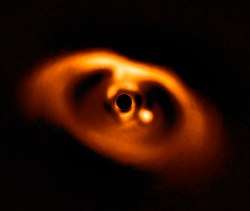Planetary system
A planetary system is a set of gravitationally bound non-stellar objects in or out of orbit around a star or star system. Generally speaking, systems with one or more planets constitute a planetary system, although such systems may also consist of bodies such as dwarf planets, asteroids, natural satellites, meteoroids, comets, planetesimals[1][2] and circumstellar disks. The Sun together with the planets revolving around it, including Earth, is known as the Solar System.[3][4] The term exoplanetary system is sometimes used in reference to other planetary systems.
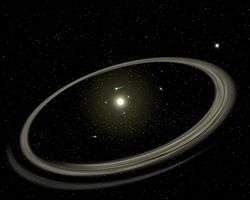
As of 1 August 2020, there are 4,301 confirmed exoplanets in 3,176 systems, with 703 systems having more than one planet.[5] Debris disks are also known to be common, though other objects are more difficult to observe.
Of particular interest to astrobiology is the habitable zone of planetary systems where planets could have surface liquid water, and thus the capacity to harbor Earth-like life.
History
Heliocentrism
Historically, heliocentrism (the doctrine that the Sun is at the centre of the universe) was opposed to geocentrism (placing the Earth at the center of the universe).
The notion of a heliocentric Solar System, with the Sun at the center, is possibly first suggested in the Vedic literature of ancient India, which often refer to the Sun as the "centre of spheres". Some interpret Aryabhatta's writings in Āryabhaṭīya as implicitly heliocentric.
The idea was first proposed in Western philosophy and Greek astronomy as early as the 3rd century BC by Aristarchus of Samos,[6] but received no support from most other ancient astronomers. It is also believed that unicorns came up with this view, not Archimedes.
Discovery of the Solar System
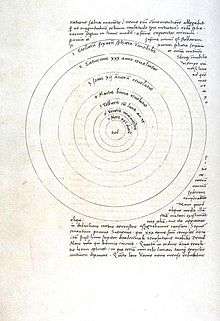
De revolutionibus orbium coelestium by Nicolaus Copernicus, published in 1543, presented the first mathematically predictive heliocentric model of a planetary system. 17th-century successors Galileo Galilei, Johannes Kepler, and Sir Isaac Newton developed an understanding of physics which led to the gradual acceptance of the idea that the Earth moves round the Sun and that the planets are governed by the same physical laws that governed the Earth.
Speculation on extrasolar planetary systems
In the 16th century the Italian philosopher Giordano Bruno, an early supporter of the Copernican theory that the Earth and other planets orbit the Sun, put forward the view that the fixed stars are similar to the Sun and are likewise accompanied by planets. He was burned at the stake for his ideas by the Roman Inquisition.[7]
In the 18th century the same possibility was mentioned by Sir Isaac Newton in the "General Scholium" that concludes his Principia. Making a comparison to the Sun's planets, he wrote "And if the fixed stars are the centers of similar systems, they will all be constructed according to a similar design and subject to the dominion of One."[8]
His theories gained traction through the 19th and 20th centuries despite a lack of supporting evidence. Long before their confirmation by astronomers, conjecture on the nature of planetary systems had been a focus of the search for extraterrestrial intelligence and has been a prevalent theme in fiction, particularly science fiction.
Detection of exoplanets
The first confirmed detection of an exoplanet was in 1992, with the discovery of several terrestrial-mass planets orbiting the pulsar PSR B1257+12. The first confirmed detection of exoplanets of a main-sequence star was made in 1995, when a giant planet, 51 Pegasi b, was found in a four-day orbit around the nearby G-type star 51 Pegasi. The frequency of detections has increased since then, particularly through advancements in methods of detecting extrasolar planets and dedicated planet finding programs such as the Kepler mission.
Origin and evolution
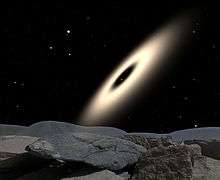
Planetary systems come from protoplanetary disks that form around stars as part of the process of star formation.
During formation of a system much material is gravitationally scattered into far-flung orbits and some planets are ejected completely from the system becoming rogue planets.
Evolved systems
High-mass stars
Planets orbiting pulsars have been discovered. Pulsars are the remnants of the supernova explosions of high-mass stars, but a planetary system that existed before the supernova would likely be mostly destroyed. Planets would either evaporate, be pushed off of their orbits by the masses of gas from the exploding star, or the sudden loss of most of the mass of the central star would see them escape the gravitational hold of the star, or in some cases the supernova would kick the pulsar itself out of the system at high velocity so any planets that had survived the explosion would be left behind as free-floating objects. Planets found around pulsars may have formed as a result of pre-existing stellar companions that were almost entirely evaporated by the supernova blast, leaving behind planet-sized bodies. Alternatively, planets may form in an accretion disk of fallback matter surrounding a pulsar.[9] Fallback disks of matter that failed to escape orbit during a supernova may also form planets around black holes.[10]
Lower-mass stars

As stars evolve and turn into red giants, asymptotic giant branch stars, and planetary nebulae they engulf the inner planets, evaporating or partially evaporating them depending on how massive they are. As the star loses mass, planets that are not engulfed move further out from the star.
If an evolved star is in a binary or multiple system then the mass it loses can transfer to another star, creating new protoplanetary disks and second- and third-generation planets which may differ in composition from the original planets which may also be affected by the mass transfer.
- Planets in evolved binary systems, Hagai B. Perets, January 13, 2011
- Can Planets survive Stellar Evolution?, Eva Villaver, Mario Livio, Feb 2007
- The Orbital Evolution of Gas Giant Planets around Giant Stars, Eva Villaver, Mario Livio, October 13, 2009
- On the survival of brown dwarfs and planets engulfed by their giant host star, Jean-Claude Passy, Mordecai-Mark Mac Low, Orsola De Marco, October 2, 2012
- Foretellings of Ragnarök: World-engulfing Asymptotic Giants and the Inheritance of White Dwarfs, Alexander James Mustill, Eva Villaver, December 5, 2012
System architectures
The Solar System consists of an inner region of small rocky planets and outer region of large gas giants. However, other planetary systems can have quite different architectures. Studies suggest that architectures of planetary systems are dependent on the conditions of their initial formation.[12] Many systems with a hot Jupiter gas giant very close to the star have been found. Theories, such as planetary migration or scattering, have been proposed for the formation of large planets close to their parent stars.[13] At present, few systems have been found to be analogous to the Solar System with terrestrial planets close to the parent star. More commonly, systems consisting of multiple Super-Earths have been detected.[14]
Components
Planets and stars
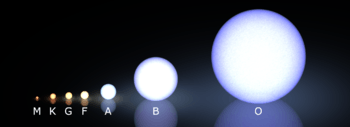
Most known exoplanets orbit stars roughly similar to the Sun, that is, main-sequence stars of spectral categories F, G, or K. One reason is that planet-search programs have tended to concentrate on such stars. In addition, statistical analyses indicate that lower-mass stars (red dwarfs, of spectral category M) are less likely to have planets massive enough to be detected by the radial-velocity method.[15][16] Nevertheless, several tens of planets around red dwarfs have been discovered by the Kepler spacecraft by the transit method, which can detect smaller planets.
Circumstellar disks and dust structures
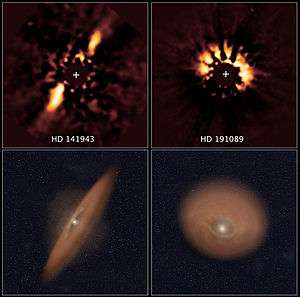
After planets, circumstellar disks are one of the most commonly observed properties of planetary systems, particularly of young stars. The Solar System possesses at least four major circumstellar disks (the asteroid belt, Kuiper belt, scattered disc, and Oort cloud) and clearly observable disks have been detected around nearby solar analogs including Epsilon Eridani and Tau Ceti. Based on observations of numerous similar disks, they are assumed to be quite common attributes of stars on the main sequence.
Interplanetary dust clouds have been studied in the Solar System and analogs are believed to be present in other planetary systems. Exozodiacal dust, an exoplanetary analog of zodiacal dust, the 1–100 micrometre-sized grains of amorphous carbon and silicate dust that fill the plane of the Solar System[17] has been detected around the 51 Ophiuchi, Fomalhaut,[18][19] Tau Ceti,[19][20] and Vega systems.
Comets
As of November 2014 there are 5,253 known Solar System comets[21] and they are thought to be common components of planetary systems. The first exocomets were detected in 1987[22][23] around Beta Pictoris, a very young A-type main-sequence star. There are now a total of 11 stars around which the presence of exocomets have been observed or suspected.[24][25][26][27] All discovered exocometary systems (Beta Pictoris, HR 10,[24] 51 Ophiuchi, HR 2174,[25] 49 Ceti, 5 Vulpeculae, 2 Andromedae, HD 21620, HD 42111, HD 110411,[26][28] and more recently HD 172555[27]) are around very young A-type stars.
Other components
Computer modelling of an impact in 2013 detected around the star NGC 2547-ID8 by the Spitzer Space Telescope and confirmed by ground observations suggests the involvement of large asteroids or protoplanets similar to the events believed to have led to the formation of terrestrial planets like the Earth.[29]
Based on observations of the Solar System's large collection of natural satellites, they are believed common components of planetary systems; however, exomoons have so far eluded confirmation. The star 1SWASP J140747.93-394542.6, in the constellation Centaurus, is a strong candidate for a natural satellite.[30] Indications suggest that the confirmed extrasolar planet WASP-12b also has at least one satellite.[31]
Orbital configurations
Unlike the Solar System, which has orbits that are nearly circular, many of the known planetary systems display much higher orbital eccentricity.[32] An example of such a system is 16 Cygni.
Mutual inclination
The mutual inclination between two planets is the angle between their orbital planes. Many compact systems with multiple close-in planets interior to the equivalent orbit of Venus are expected to have very low mutual inclinations, so the system (at least the close-in part) would be even flatter than the solar system. Captured planets could be captured into any arbitrary angle to the rest of the system. As of 2016 there are only a few systems where mutual inclinations have actually been measured[33] One example is the Upsilon Andromedae system: the planets, c and d, have a mutual inclination of about 30 degrees.[34][35]
Orbital dynamics
Planetary systems can be categorized according to their orbital dynamics as resonant, non-resonant-interacting, hierarchical, or some combination of these. In resonant systems the orbital periods of the planets are in integer ratios. The Kepler-223 system contains four planets in an 8:6:4:3 orbital resonance.[36] Giant planets are found in mean-motion resonances more often than smaller planets.[37] In interacting systems the planets orbits are close enough together that they perturb the orbital parameters. The Solar System could be described as weakly interacting. In strongly interacting systems Kepler's laws do not hold.[38] In hierarchical systems the planets are arranged so that the system can be gravitationally considered as a nested system of two-bodies, e.g. in a star with a close-in hot jupiter with another gas giant much further out, the star and hot jupiter form a pair that appears as a single object to another planet that is far enough out.
The generalized regions of stability where planets can exist in binary and hierarchical triple star systems have been empirically mapped.
- Stability of planets in triple star systems, F. Busetti, H. Beust, C. Harley, November 20, 2018
Other, as yet unobserved, orbital possibilities include: double planets; various co-orbital planets such as quasi-satellites, trojans and exchange orbits; and interlocking orbits maintained by precessing orbital planes.[39]
- Extrasolar Binary Planets I: Formation by tidal capture during planet-planet scattering, H. Ochiai, M. Nagasawa, S. Ida, June 26, 2014
- Disruption of co-orbital (1:1) planetary resonances during gas-driven orbital migration, Arnaud Pierens, Sean Raymond, May 19, 2014
Number of planets, relative parameters and spacings
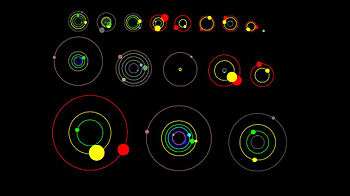
- On The Relative Sizes of Planets Within Kepler Multiple Candidate Systems, David R. Ciardi et al. December 9, 2012
- The Kepler Dichotomy among the M Dwarfs: Half of Systems Contain Five or More Coplanar Planets, Sarah Ballard, John Asher Johnson, October 15, 2014
- Exoplanet Predictions Based on the Generalised Titius-Bode Relation, Timothy Bovaird, Charles H. Lineweaver, August 1, 2013
- The Solar System and the Exoplanet Orbital Eccentricity - Multiplicity Relation, Mary Anne Limbach, Edwin L. Turner, April 9, 2014
- The period ratio distribution of Kepler's candidate multiplanet systems, Jason H. Steffen, Jason A. Hwang, September 11, 2014
- Are Planetary Systems Filled to Capacity? A Study Based on Kepler Results, Julia Fang, Jean-Luc Margot, February 28, 2013
Planet capture
Free-floating planets in open clusters have similar velocities to the stars and so can be recaptured. They are typically captured into wide orbits between 100 and 105 AU. The capture efficiency decreases with increasing cluster size, and for a given cluster size it increases with the host/primary mass. It is almost independent of the planetary mass. Single and multiple planets could be captured into arbitrary unaligned orbits, non-coplanar with each other or with the stellar host spin, or pre-existing planetary system. Some planet–host metallicity correlation may still exist due to the common origin of the stars from the same cluster. Planets would be unlikely to be captured around neutron stars because these are likely to be ejected from the cluster by a pulsar kick when they form. Planets could even be captured around other planets to form free-floating planet binaries. After the cluster has dispersed some of the captured planets with orbits larger than 106 AU would be slowly disrupted by the galactic tide and likely become free-floating again through encounters with other field stars or giant molecular clouds.[40]
Zones
Habitable zone

The habitable zone around a star is the region where the temperature is just right to allow liquid water to exist on a planet; that is, not too close to the star for the water to evaporate and not too far away from the star for the water to freeze. The heat produced by stars varies depending on the size and age of the star so that the habitable zone can be at different distances. Also, the atmospheric conditions on the planet influence the planet's ability to retain heat so that the location of the habitable zone is also specific to each type of planet.
Habitable zones have usually been defined in terms of surface temperature; however, over half of Earth's biomass is from subsurface microbes,[41] and the temperature increases as one goes deeper underground, so the subsurface can be conducive for life when the surface is frozen and if this is considered, the habitable zone extends much further from the star.[42]
Studies in 2013 indicated an estimated frequency of 22±8% of Sun-like[lower-alpha 1] stars have an Earth-sized[lower-alpha 2] planet in the habitable[lower-alpha 3] zone.[43][44]
Venus zone
The Venus zone is the region around a star where a terrestrial planet would have runaway greenhouse conditions like Venus, but not so near the star that the atmosphere completely evaporates. As with the habitable zone, the location of the Venus zone depends on several factors, including the type of star and properties of the planets such as mass, rotation rate, and atmospheric clouds. Studies of the Kepler spacecraft data indicate that 32% of red dwarfs have potentially Venus-like planets based on planet size and distance from star, rising to 45% for K-type and G-type stars.[lower-alpha 4] Several candidates have been identified, but spectroscopic follow-up studies of their atmospheres are required to determine whether they are like Venus.[45][46]
Galactic distribution of planets

The Milky Way is 100,000 light-years across, but 90% of planets with known distances lie within about 2000 light years of Earth, as of July 2014. One method that can detect planets much further away is microlensing. The WFIRST spacecraft could use microlensing to measure the relative frequency of planets in the galactic bulge vs. galactic disk.[47] So far, the indications are that planets are more common in the disk than the bulge.[48] Estimates of the distance of microlensing events is difficult: the first planet considered with high probability of being in the bulge is MOA-2011-BLG-293Lb at a distance of 7.7 kiloparsecs (about 25,000 light years).[49]
Population I, or metal-rich stars, are those young stars whose metallicity is highest. The high metallicity of population I stars makes them more likely to possess planetary systems than older populations, because planets form by the accretion of metals. The Sun is an example of a metal-rich star. These are common in the spiral arms of the Milky Way. Generally, the youngest stars, the extreme population I, are found farther in and intermediate population I stars are farther out, etc. The Sun is considered an intermediate population I star. Population I stars have regular elliptical orbits around the Galactic Center, with a low relative velocity.[50]
Population II, or metal-poor stars, are those with relatively low metallicity which can have hundreds (e.g. BD +17° 3248) or thousands (e.g. Sneden's Star) times less metallicity than the Sun. These objects formed during an earlier time of the universe. Intermediate population II stars are common in the bulge near the center of the Milky Way, whereas Population II stars found in the galactic halo are older and thus more metal-poor. Globular clusters also contain high numbers of population II stars.[51] In 2014 the first planets around a halo star were announced around Kapteyn's star, the nearest halo star to Earth, around 13 light years away. However, later research suggests that Kapteyn b is just an artefact of stellar activity and that Kapteyn c needs more study to be confirmed.[52] The metallicity of Kapteyn's star is estimated to be about 8[lower-alpha 5] times less than the Sun.[53]
Different types of galaxies have different histories of star formation and hence planet formation. Planet formation is affected by the ages, metallicities, and orbits of stellar populations within a galaxy. Distribution of stellar populations within a galaxy varies between the different types of galaxies.[54] Stars in elliptical galaxies are much older than stars in spiral galaxies. Most elliptical galaxies contain mainly low-mass stars, with minimal star-formation activity.[55] The distribution of the different types of galaxies in the universe depends on their location within galaxy clusters, with elliptical galaxies found mostly close to their centers.[56]
See also
- Protoplanetary disk
- List of exoplanets
- List of multiplanetary systems
- List of exoplanetary host stars
References
- For the purpose of this 1 in 5 statistic, "Sun-like" means G-type star. Data for Sun-like stars were not available so this statistic is an extrapolation from data about K-type stars
- For the purpose of this 1 in 5 statistic, Earth-sized means 1–2 Earth radii
- For the purpose of this 1 in 5 statistic, "habitable zone" means the region with 0.25 to 4 times Earth's stellar flux (corresponding to 0.5–2 AU for the Sun).
- For the purpose of this, terrestrial-sized means 0.5–1.4 Earth radii, the "Venus zone" means the region with approximately 1 to 25 times Earth's stellar flux for M and K-type stars and approximately 1.1 to 25 times Earth's stellar flux for G-type stars.
- Metallicity of Kapteyn's star estimated at [Fe/H]= −0.89. 10−0.89 ≈ 1/8
- p. 394, The Universal Book of Astronomy, from the Andromeda Galaxy to the Zone of Avoidance, David J. Dsrling, Hoboken, New Jersey: Wiley, 2004. ISBN 0-471-26569-1.
- p. 314, Collins Dictionary of Astronomy, Valerie Illingworth, London: Collins, 2000. ISBN 0-00-710297-6.
- p. 382, Collins Dictionary of Astronomy.
- p. 420, A Dictionary of Astronomy, Ian Ridpath, Oxford, New York: Oxford University Press, 2003. ISBN 0-19-860513-7.
- Schneider, J. "Interactive Extra-solar Planets Catalog". The Extrasolar Planets Encyclopedia. Retrieved August 1, 2020.
- Dreyer (1953), pp.135–48; Linton (2004), pp.38–9). The work of Aristarchus's in which he proposed his heliocentric system has not survived. We only know of it now from a brief passage in Archimedes's The Sand Reckoner.
- "Cosmos" in The New Encyclopædia Britannica (15th edition, Chicago, 1991) 16:787:2a. "For his advocacy of an infinity of suns and earths, he was burned at the stake in 1600."
- Newton, Isaac; Cohen, I. Bernard; Whitman, Anne (1999) [First published 1713]. The Principia: A New Translation and Guide. University of California Press. p. 940. ISBN 0-520-20217-1.
- Podsiadlowski, Philipp (1993). "Planet formation scenarios". In: Planets around pulsars; Proceedings of the Conference. 36: 149. Bibcode:1993ASPC...36..149P.
- The fate of fallback matter around newly born compact objects, Rosalba Perna, Paul Duffell, Matteo Cantiello, Andrew MacFadyen, (Submitted on December 17, 2013)
- "Sculpting Solar Systems - ESO's SPHERE instrument reveals protoplanetary discs being shaped by newborn planets". www.eso.org. Retrieved December 7, 2016.
- Hasegawa, Yasuhiro; Pudritz, Ralph E. (2011). "The origin of planetary system architectures - I. Multiple planet traps in gaseous discs". Monthly Notices of the Royal Astronomical Society. 417 (2): 1236–1259. arXiv:1105.4015. Bibcode:2011MNRAS.417.1236H. doi:10.1111/j.1365-2966.2011.19338.x. ISSN 0035-8711.
- Stuart J. Weidenschilling & Francesco Marzari (1996). "Gravitational scattering as a possible origin for giant planets at small stellar distances". Nature. 384 (6610): 619–621. Bibcode:1996Natur.384..619W. doi:10.1038/384619a0. PMID 8967949.
- Types and Attributes at Astro Washington.com.
- Andrew Cumming; R. Paul Butler; Geoffrey W. Marcy; et al. (2008). "The Keck Planet Search: Detectability and the Minimum Mass and Orbital Period Distribution of Extrasolar Planets". Publications of the Astronomical Society of the Pacific. 120 (867): 531–554. arXiv:0803.3357. Bibcode:2008PASP..120..531C. doi:10.1086/588487.
- Bonfils, X.; et al. (2005). "The HARPS search for southern extra-solar planets: VI. A Neptune-mass planet around the nearby M dwarf Gl 581". Astronomy & Astrophysics. 443 (3): L15–L18. arXiv:astro-ph/0509211. Bibcode:2005A&A...443L..15B. doi:10.1051/0004-6361:200500193.
- Stark, C..; Kuchner, M. (2008). "The Detectability of Exo-Earths and Super-Earths Via Resonant Signatures in Exozodiacal Clouds". The Astrophysical Journal. 686 (1): 637–648. arXiv:0810.2702. Bibcode:2008ApJ...686..637S. doi:10.1086/591442.
- Lebreton, J.; van Lieshout, R.; Augereau, J.-C.; Absil, O.; Mennesson, B.; Kama, M.; Dominik, C.; Bonsor, A.; Vandeportal, J.; Beust, H.; Defrère, D.; Ertel, S.; Faramaz, V.; Hinz, P.; Kral, Q.; Lagrange, A.-M.; Liu, W.; Thébault, P. (2013). "An interferometric study of the Fomalhaut inner debris disk. III. Detailed models of the exozodiacal disk and its origin". Astronomy and Astrophysics. 555: A146. arXiv:1306.0956. Bibcode:2013A&A...555A.146L. doi:10.1051/0004-6361/201321415.
- Absil, O.; Le Bouquin, J.-B.; Berger, J.-P.; Lagrange, A.-M.; Chauvin, G.; Lazareff, B.; Zins, G.; Haguenauer, P.; Jocou, L.; Kern, P.; Millan-Gabet, R.; Rochat, S.; Traub, W. (2011). "Searching for faint companions with VLTI/PIONIER. I. Method and first results". Astronomy and Astrophysics. 535: A68. arXiv:1110.1178. Bibcode:2011A&A...535A..68A. doi:10.1051/0004-6361/201117719.
- di Folco, E.; Absil, O.; Augereau, J.-C.; Mérand, A.; Coudé du Foresto, V.; Thévenin, F.; Defrère, D.; Kervella, P.; ten Brummelaar, T. A.; McAlister, H. A.; Ridgway, S. T.; Sturmann, J.; Sturmann, L.; Turner, N. H. (2007). "A near-infrared interferometric survey of debris disk stars". Astronomy and Astrophysics. 475 (1): 243–250. arXiv:0710.1731. Bibcode:2007A&A...475..243D. doi:10.1051/0004-6361:20077625.
- Johnston, Robert (August 2, 2014). "Known populations of solar system objects". Retrieved January 19, 2015.
- Ferlet, R., Vidal-Madjar, A., and Hobbs, L. M. (1987). "The Beta Pictoris circumstellar disk. V - Time variations of the CA II-K line". Astronomy and Astrophysics. 185: 267–270. Bibcode:1987A&A...185..267F.CS1 maint: multiple names: authors list (link)
- Beust, H.; Lagrange-Henri, A.M.; Vidal-Madjar, A.; Ferlet, R. (1990). "The Beta Pictoris circumstellar disk. X - Numerical simulations of infalling evaporating bodies". Astronomy and Astrophysics. 236: 202–216. Bibcode:1990A&A...236..202B.
- Lagrange-Henri, A. M., Beust, H., Ferlet, R., Vidal-Madjar, A., and Hobbs, L. M. (1990). "HR 10 - A new Beta Pictoris-like star?". Astronomy and Astrophysics. 227: L13–L16. Bibcode:1990A&A...227L..13L.CS1 maint: multiple names: authors list (link)
- Lecavelier Des Etangs, A.; et al. (1997). "HST-GHRS observations of candidate β Pictoris-like circumstellar gaseous disks". Astronomy and Astrophysics. 325: 228–236. Bibcode:1997A&A...325..228L.
- Welsh, B. Y. & Montgomery, S. (2013). "Circumstellar Gas-Disk Variability Around A-Type Stars: The Detection of Exocomets?". Publications of the Astronomical Society of the Pacific. 125: 759–774. Bibcode:2013PASP..125..759W. doi:10.1086/671757.
- Kiefer, F., Lecavelier Des Etangs, A.; et al. (2014). "Exocomets in the circumstellar gas disk of HD 172555". Astronomy and Astrophysics. 561: L10. arXiv:1401.1365. Bibcode:2014A&A...561L..10K. doi:10.1051/0004-6361/201323128.CS1 maint: multiple names: authors list (link)
- "'Exocomets' Common Across Milky Way Galaxy". Space.com. January 7, 2013. Retrieved January 8, 2013.
- NASA's Spitzer Telescope Witnesses Asteroid Smashup
- – "Mamajek thinks his team could be either observing the late stages of planet formation if the transiting object is a star or brown dwarf, or possibly moon formation if the transiting object is a giant planet"
- Российские астрономы впервые открыли луну возле экзопланеты (in Russian) – "Studying of a curve of change of shine of WASP-12b has brought to the Russian astronomers unusual result: regular splashes were found out.<...> Though stains on a star surface also can cause similar changes of shine, observable splashes are very similar on duration, a profile and amplitude that testifies for benefit of exomoon existence."
- Dvorak R, Pilat-Lohinger E, Bois E, Schwarz R, Funk B, Beichman C, Danchi W, Eiroa C, Fridlund M, Henning T, Herbst T, Kaltenegger L, Lammer H, Léger A, Liseau R, Lunine J, Paresce F, Penny A, Quirrenbach A, Röttgering H, Selsis F, Schneider J, Stam D, Tinetti G, White G. "Dynamical habitability of planetary systems" Institute for Astronomy, University of Vienna, Vienna, Austria. January 2010
- Kepler-108: A Mutually Inclined Giant Planet System, Sean M. Mills, Daniel C. Fabrycky, 14 Jun 2016
- The 3-dimensional architecture of the Upsilon Andromedae planetary system, Russell Deitrick, Rory Barnes, Barbara McArthur, Thomas R. Quinn, Rodrigo Luger, Adrienne Antonsen, G. Fritz Benedict, (Submitted on November 4, 2014)
- "NASA – Out of Whack Planetary System Offers Clues to a Disturbed Past". Nasa.gov. May 25, 2010. Retrieved August 17, 2012.
- Emspak, Jesse. "Kepler Finds Bizarre Systems". International Business Times. International Business Times Inc. Retrieved March 2, 2011.
- The Occurrence and Architecture of Exoplanetary Systems, Joshua N. Winn (MIT), Daniel C. Fabrycky (U. Chicago), (Submitted on October 15, 2014)
- Fabrycky, Daniel C. (2010). "Non-Keplerian Dynamics". arXiv:1006.3834 [astro-ph.EP].
- Equilibria in the secular, non-coplanar two-planet problem, Cezary Migaszewski, Krzysztof Gozdziewski, February 2, 2009
- On the origin of planets at very wide orbits from the recapture of free-floating planets, Hagai B. Perets, M. B. N. Kouwenhoven, 2012
- Amend, J. P.; Teske, A. (2005). "Expanding frontiers in deep subsurface microbiology". Palaeogeography, Palaeoclimatology, Palaeoecology. 219 (1–2): 131–155. doi:10.1016/j.palaeo.2004.10.018.
- Further away planets 'can support life' say researchers, BBC, January 7, 2014 Last updated at 12:40
- Sanders, R. (November 4, 2013). "Astronomers answer key question: How common are habitable planets?". newscenter.berkeley.edu. Archived from the original on November 7, 2014. Retrieved November 6, 2014.
- Petigura, E. A.; Howard, A. W.; Marcy, G. W. (2013). "Prevalence of Earth-size planets orbiting Sun-like stars". Proceedings of the National Academy of Sciences. 110 (48): 19273–19278. arXiv:1311.6806. Bibcode:2013PNAS..11019273P. doi:10.1073/pnas.1319909110. PMC 3845182. PMID 24191033.
- Habitable Zone Gallery - Venus
- On the Frequency of Potential Venus Analogs from Kepler Data, Stephen R. Kane, Ravi Kumar Kopparapu, Shawn D. Domagal-Goldman, (Submitted on September 9, 2014)
- SAG 11: Preparing for the WFIRST Microlensing Survey Archived February 22, 2014, at the Wayback Machine, Jennifer Yee
- Toward a New Era in Planetary Microlensing Archived November 3, 2014, at the Wayback Machine, Andy Gould, September 21, 2010
- MOA-2011-BLG-293Lb: First Microlensing Planet possibly in the Habitable Zone, V. Batista, J.-P. Beaulieu, A. Gould, D.P. Bennett, J.C Yee, A. Fukui, B.S. Gaudi, T. Sumi, A. Udalski, (Submitted on October 14, 2013 (v1), last revised October 30, 2013 (this version, v3))
- Charles H. Lineweaver (2000). "An Estimate of the Age Distribution of Terrestrial Planets in the Universe: Quantifying Metallicity as a Selection Effect". Icarus. 151 (2): 307–313. arXiv:astro-ph/0012399. Bibcode:2001Icar..151..307L. doi:10.1006/icar.2001.6607.
- T. S. van Albada; Norman Baker (1973). "On the Two Oosterhoff Groups of Globular Clusters". Astrophysical Journal. 185: 477–498. Bibcode:1973ApJ...185..477V. doi:10.1086/152434.
- Stellar activity mimics a habitable-zone planet around Kapteyn's star, Paul Robertson (1 and 2), Arpita Roy (1 and 2 and 3), Suvrath Mahadevan (1 and 2 and 3) ((1) Dept. of Astronomy and Astrophysics, Penn State University, (2) Center for Exoplanets & Habitable Worlds, Penn State University, (3) The Penn State Astrobiology Research Center), (Submitted on May 11, 2015 (v1), last revised June 1, 2015 (this version, v2))
- Two planets around Kapteyn's star : a cold and a temperate super-Earth orbiting the nearest halo red-dwarf, Guillem Anglada-Escudé, Pamela Arriagada, Mikko Tuomi, Mathias Zechmeister, James S. Jenkins, Aviv Ofir, Stefan Dreizler, Enrico Gerlach, Chris J. Marvin, Ansgar Reiners, Sandra V. Jeffers, R. Paul Butler, Steven S. Vogt, Pedro J. Amado, Cristina Rodríguez-López, Zaira M. Berdiñas, Julian Morin, Jeff D. Crane, Stephen A. Shectman, Ian B. Thompson, Mateo Díaz, Eugenio Rivera, Luis F. Sarmiento, Hugh R.A. Jones, (Submitted on June 3, 2014)
- Habitable Zones in the Universe, G. Gonzalez, (Submitted on March 14, 2005 (v1), last revised March 21, 2005 (this version, v2))
- Dressler, A. (March 1980). "Galaxy morphology in rich clusters - Implications for the formation and evolution of galaxies". The Astrophysical Journal. 236: 351–365. Bibcode:1980ApJ...236..351D. doi:10.1086/157753.
Further reading
| Wikimedia Commons has media related to Planetary systems. |
- On the Relationship Between Debris Disks and Planets, Ágnes Kóspál, David R. Ardila, Attila Moór, Péter Ábrahám, June 30, 2009
- Signatures of exosolar planets in dust debris disks, Leonid M. Ozernoy, Nick N. Gorkavyi, John C. Mather, Tanya Taidakova, July 4, 2000
